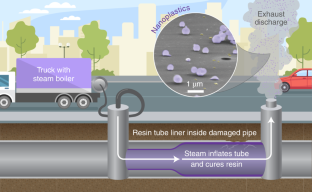配管補修技術の普及により、ナノプラスチックが大気中に放出されることが判明 Widespread pipe repair technique sends nanoplastics into the atmosphere, new study finds
2022-10-06 パデュー大学
下水道管が破損した場合、物理的に穴を掘って管の一部を取り替えるか、人間の動脈の弱った部分のように扱ってステントを入れるかのどちらかを選択することになる。
樹脂をしみこませた袋をパイプに入れ、大きな袋を作り、それを固定する。これで、掘削することなくパイプを密閉することができる。非常に高度で実用的な技術です。袋を膨らませるときに加圧蒸気を使いますが、その加圧蒸気が化学物質のプルームとして放出される。その結果、ナノプラスチック粒子など、かなりの量の汚染物質が発生することがわかった。
このプロセスが行われる現代のあらゆる都市や郊外の周辺には、これまで考慮も検討もされなかったマイクロプラスチックやナノプラスチックの、数え切れないほどの重要な発生源が存在することになる
大気中に浮遊するマイクロプラスチックとナノプラスチックの量は、風によって運ばれてくるものだけだと考えられてきたが、現代社会全体で一般的に使われている、ナノプラスチック汚染を大気中に投棄するプロセスが存在することを示した。
この新しい研究は、これらの作業員やそれ以前の作業員が、マイクロプラスチックやナノプラスチックを吸い込んでいる可能性が高いことを示している。
<関連情報>
- https://www.purdue.edu/newsroom/releases/2022/Q4/somethings-in-the-air-its-nanoplastic-pollution.html
- https://www.nature.com/articles/s41565-022-01219-9
下水道管の補修に伴うナノプラスチックの大気放出について Atmospheric emission of nanoplastics from sewer pipe repairs
Ana C. Morales,Jay M. Tomlin,Christopher P. West,Felipe A. Rivera-Adorno,Brianna N. Peterson,Steven A. L. Sharpe,Yoorae Noh,Seyedeh M. T. Sendesi,Brandon E. Boor,John A. Howarter,Ryan C. Moffet,Swarup China,Brian T. O’Callahan,Patrick Z. El-Khoury,Andrew J. Whelton & Alexander Laskin
Nature Nanotechnology Published:06 October 2022
DOI:https://doi.org/10.1038/s41565-022-01219-9

Abstract
Nanoplastic particles are inadequately characterized environmental pollutants that have adverse effects on aquatic and atmospheric systems, causing detrimental effects to human health through inhalation, ingestion and skin penetration1,2,3. At present, it is explicitly assumed that environmental nanoplastics (EnvNPs) are weathering fragments of microplastic or larger plastic debris that have been discharged into terrestrial and aquatic environments, while atmospheric EnvNPs are attributed solely to aerosolization by wind and other mechanical forces. However, the sources and emissions of unintended EnvNPs are poorly understood and are therefore largely unaccounted for in various risk assessments4. Here we show that large quantities of EnvNPs may be directly emitted into the atmosphere as steam-laden waste components discharged from a technology commonly used to repair sewer pipes in urban areas. A comprehensive chemical analysis of the discharged waste condensate has revealed the abundant presence of insoluble colloids, which after drying form solid organic particles with a composition and viscosity consistent with EnvNPs. We suggest that airborne emissions of EnvNPs from these globally used sewer repair practices may be prevalent in highly populated urban areas5, and may have important implications for air quality and toxicological levels that need to be mitigated.



